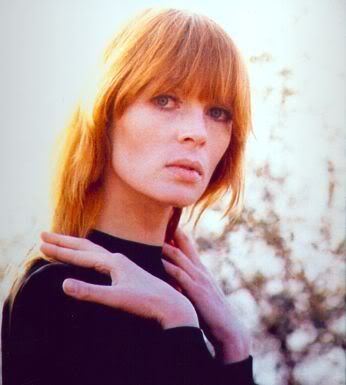|
invito al cielo
Join Date: Mar 2006
Posts: 8,212
|
By the time she came to record her next album, in 1969, all that cool conservatism was changing into something more original, more personal, far more unexpected. The Marble Index is one of the most uncompromising albums ever to be filed under rock: the first to abandon conventional structures and instrumentation, it was really the product of two European sensibilities — Nico's and John Cale's, the glacial mood and now-deepened voice of one allied to astonishingly imaginative musicianship of the other. The key to it lay in her espousal of a small portable Indian harmonium which she had bought, mastered in a basic sort of way, and used as the tool not just of performance but of composition. Like many rock composers, her technical limitations defined her style: the see-sawing two-chord vamps provided the hypnotic setting for her simple but often fresh melodies, which seem to have sprung from some ancient Central European folk memory. The plainless of the material left Cale plenty of room in which to display his matchless command of contrasting and sometimes conflicting sonorities (what, for example, has the dark twangy guitar which stumbles to a subdued halt in the final seconds of Lawns of Dawns to do with the weird clattering and tintinnabulating that engulfs the rest of the song ?). On the other hand, with Nibelungen (one of two previously unreleased tracks included here), he could leave her voice totally unaccompanied, eliminating even the harmonium.
Despite winning the awestruck admiration of the readers of such counter-cultural news sheets as the East Village Other and International Times, The Marble Index failed to challenge the supremacy of Nashville Skyline, From Elvis in Memphis, Abbey Road and Diana Ross And The Supremes Meet The Temptations in the album charts of 1969. It marked the end of her relationship with the Elektra label, which had seemed (thanks to its patronage of Tim Buckley, the Doors and others) a natural home for her. Subsequent solo albums were to appear on Warner Brothers (Desertshore, 1970), Island (The End, 1974), Aura (Drama of Exile, 1981), VU (Live in Denmark, 1983), Beggars' Banquet (Camera Obscura, 1985) and Dojo (Behind the Iron Curtain, 1986).
Such frequent movement might suggest either the fickleness and fast-results demands of the record industry, or an artist with a difficult temperament. Or both, which was the case of Nico. Even when she produced something as gorgeous as S„eta, a single released on a British indie label in the early Eighties, she managed to press self-destruction button. She was there and then she was not there. That was Nico, and it was what her original fans had sensed from the start. The music was part of the life, not — however much she protested that she wanted to be famous or popular — simply the means to an end in a career structure.
People who met her in later years were often disconcerted. Fed on the image of the aloof Dolce Vita blonde ("another cooler Dietrich for another cooler generation", in John Wilcock's unforgettable description), they found an earthy contralto with dark hennaed hair, shapeless brown robes in thick woollen material covering Cossack trousers and scuffed motorcycle boots. On stage she sat impassive, imperturbable, intoning her songs and pumping the harmonium and occasionally smiling her small, secretive smile regardless of whether the audience was worshipful or derisive. (She loved to shock: once, in West Berlin in the mid-Seventies, I saw the crowd's respect turn to rage as she sang through all the banned verses of Deutschland ‹ber Alles, never missing a beat while Cale and Brian Eno, her accompanists, provided the noises of a thousand-bomber raid as a background. Plastic cushions flew through the spotlights as Cale and Eno raised the volume to drown the booing. Goodness knows what was going through her mind just then).
She spent most of her last years fulfilling the demands of a series of threadbare tours, often in Eastern Europe, once in Japan, usually with a small band of devoted English musicians (notably the keyboardist James Young). In private life she shuttled between homes in Manchester and Ibiza, which she had loved for many years and where she died on July 18, 1988, falling from her bicycle after a heart attack, aged 45.
I met her first in 1970, ready to be dazzled by what I imagined her to be, bemused by the fact that she looked nothing like the album covers yet only slightly discomfited when she gently cut short our lunchtime interview and left the pub with a stranger from the next table. It seemed to fit the image; the more so when she called on the telephone a few hours later, ending her conversation with the words: "I'm flying to Ibiza. It's my favourite place. I think I'll die there." That seemed achingly romantic at the time, but after subsequent encounters I came to think that her life was not really romantic at all. There's nothing romantic about heroin, about the scuffing and the cadging and the hustling. Rather than the imaginary romance of the myth, what I hear now in her music — and particularly in The Marble Index — is the combination of a naturally poetic sensibility and an unflinching originality. Back in the Sixties, hanging out at the Factory or on the set of Ready, Steady, Go, who could have guessed that she would turn out to be not a butterfly but a stoic.
 http://smironne.free.fr/NICO/marb.php
http://smironne.free.fr/NICO/marb.php |